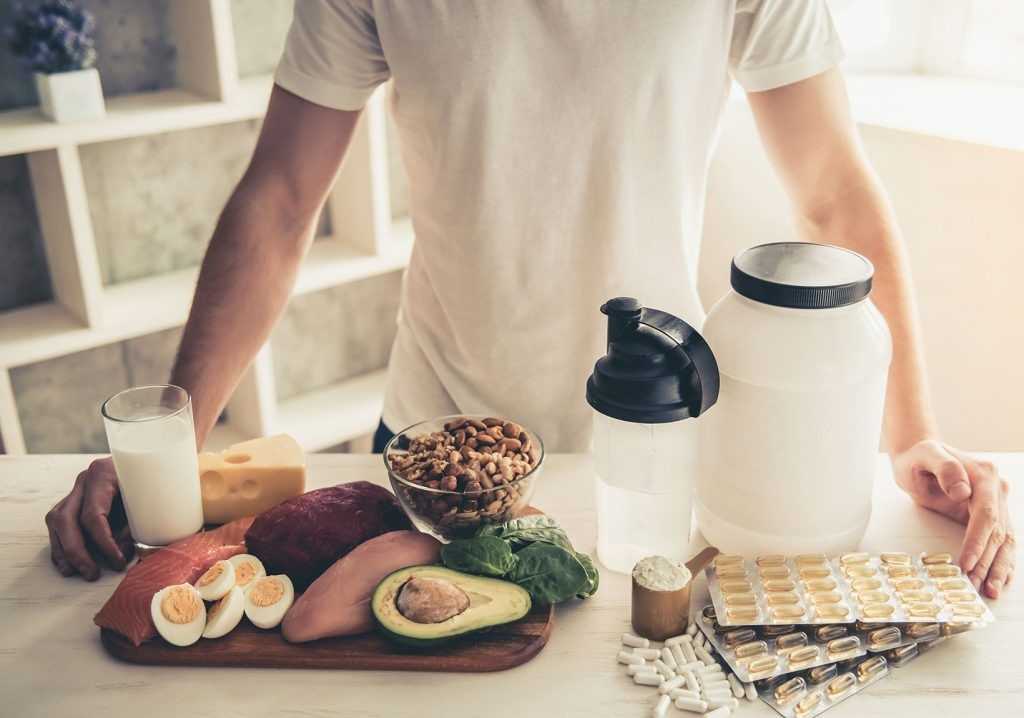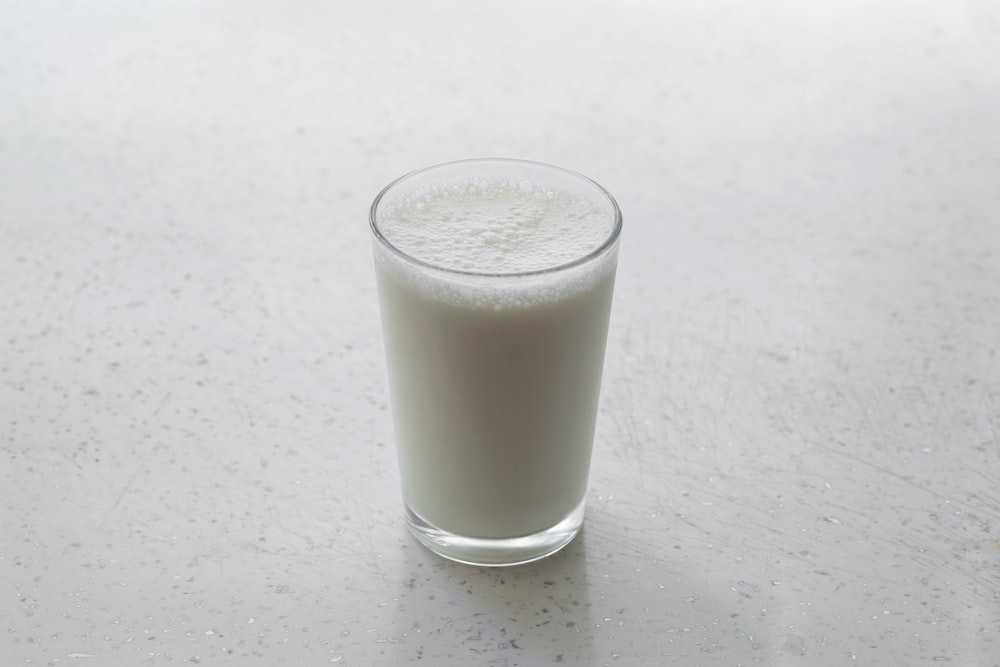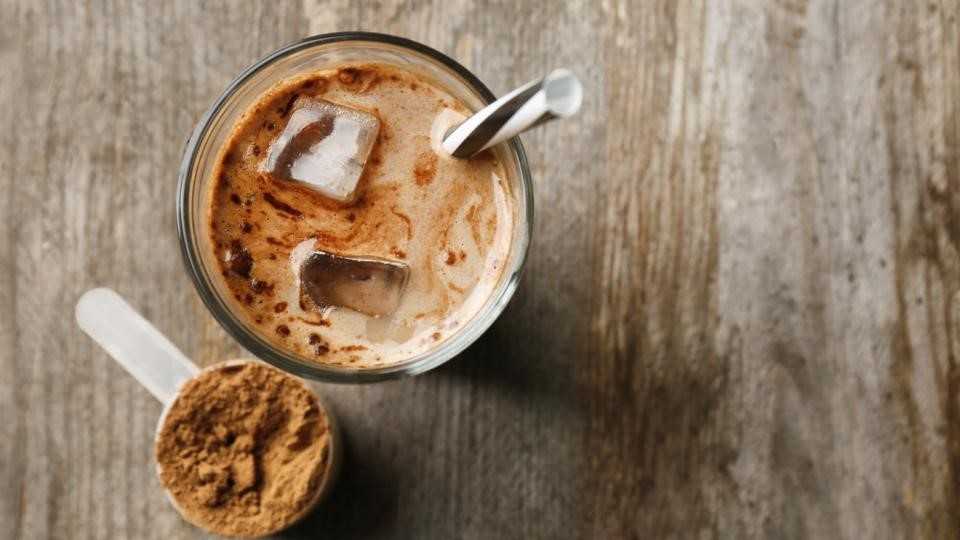We need to get one thing clear in our minds, that essentially our body doesn’t care whether a type of protein comes from food or in a supplement form, when it comes to the amino acid requirements.

A study, found whether the source of protein supplementation (whey protein supplemented vs. food protein sources only) influences metabolic and physical performance outcomes.
Researchers compared the effects of a high protein diet consisting of either whey protein supplementation (consumed as three of the six daily meals at 20–25g of whey protein/meal) or protein-rich food sources (consumed for all six daily meals at 20-25g protein/meal) combined with RISE (resistance exercise, interval sprint exercise, stretching (yoga, pilates), and endurance exercise) training on fitness-related performance outcomes, as well as cardio-metabolic and body composition measures.
The main findings of this study were that increased dietary protein from either whey or whole foods, combined with RISE exercise training for 16 weeks improved:
- physical performance outcomes (upper and lower body maximal strength and endurance, flexibility, balance, and handgrip strength) and;
- body composition (weight, waist circumference, body fat percentage, abdominal fat, visceral fat, and lean mass) and cardiometabolic markers (systolic blood pressure, blood glucose, LDL, total cholesterol, adiponectin) in both groups.
Collectively, these results demonstrate, that sources of dietary protein (whey vs. whole food) do not appear to be important factors determining such improvements.
A 2017 study, investigated the impact of co-ingesting milk fat with casein on amino acid appearance in the circulation and the postprandial muscle protein synthetic response in 24 healthy older men, who received 20gm casein with or without milk fat. Researchers found that, co-ingesting milk fat with casein does not impair amino acids in the circulation and does not modulate muscle protein synthesis rates.
A 2015 study, determined the impact of milk on casein protein digestion and absorption and muscle protein synthesis in 32 older men, who received 25gm creatine dissolved in either milk or water. Researchers, here also found that, casein ingestion in milk delays protein digestion and absorption but does not modulate muscle protein synthesis when compared to the ingestion of casein in water, in healthy older men.
But muscle protein synthesis is not just determined by the protein content in the supplement or the whole foods.
A 2006 study, determined the response of muscle protein balance following resistance exercise to ingestion of nutrients as components of milk. For the study, three groups of volunteers ingested one of three milk drinks each: 237g of fat-free milk, 237g of whole milk, and 393g of fat-free and whole milk, mixed. Milk was ingested 1h following a leg resistance exercise routine. Researchers found that, whole milk may have increased utilization of available amino acids for protein synthesis.

Same was the case with eggs. A 2017 study, compared the whole-body and muscle protein synthesis after the consumption of whole eggs with egg whites during exercise recovery in young men. 10 resistance-trained men, post exercise, consumed either whole eggs (18g protein, 17g fat) or egg whites (18g protein, 0g fat).
Researchers found that, ingestion of whole eggs immediately after resistance exercise resulted in greater stimulation of muscle protein synthesis than did the ingestion of egg whites, despite being matched for protein content in young men.
Another 2017 study, suggested that protein supplements are processed materials and often do not contain other essential nutrients required for the sustenance of a healthy lifestyle. It is suggested that the required protein intake should be obtained from natural food sources and protein supplementation should be resorted to only if sufficient protein is not available in the normal diet.
Whey Protein Advantages & Disadvantages:
- COST: if you study online about the advantages of whey, then most of the international sites tell you that, weight by weight, protein supplements come out to be cheaper. But that’s not the case in India. In India, the protein supplements do not come out to be cheap in any way, and sometimes as compared to whole foods, for same amount of protein, the cost is more than double. Let’s calculate and see:
Let’s compare two sources of proteins with high biological value: i.e. whole eggs and whey. The only comparison would be proteins, not the other micronutrients.
On an average, the cost of egg in Indian market = Rs. 6-8/piece
Now, the protein content in eggs = 6-7gms/whole egg
Now, a scoop of whey from any average whey protein supplement ranges from = <22gms – >30gms, depending on the type of protein supplement and size of the scoop.
let’s take an average of 24gms in a scoop.
This means, to get the same amount of protein from eggs, you would need to consume app. 4 eggs.
Now, the cost of an average whey protein isolate supplement (5lbs or 2.27kg) in India is app. = Rs. <4500 – >8000
Let’s take an average price of Rs. 5000 for a 5lbs whey isolate protein supplement in India.
On an average, the serving per 5lb box = 70
This means, the price for each scoop of whey we take = 5000/70 = app. Rs. 71
So, 4 eggs = 28gms protein = 8×4 = Rs. 32;
And 1 scoop whey = 28gms protein = Rs. 70
This means to get the same amount of protein through a supplement, you will have to spend almost double the amount of money.

- CONVENIENCE: yes, this can be a welcome advantage of any supplement. Whey is easy to carry, less messy, nothing to cook, and you can have it anywhere. Whole foods, on the other hand, need time to cook, and need better preservation and handling.
That’s another reason its excellent for people for whom digesting large amount of solid food may not be possible or is not digestible. For e.g. elderly, serious medical cases, pregnant women, sportsmen etc.
- CALORIES: one of the major advantages of protein supplements is the amount of protein vs fats & carbs, as compared to whole foods. Protein supplements have much less amount of carbs and fats, as compared to the same amount of whole foods.
| POWDER (100GM) | ENERGY | PROTEINS | CARBS | FATS |
| WHOLE MILK POWDER | 496kcal | 26g | 38g | 27g |
| WHEY PROTEIN CONCENTRATE | 352kcal | 78g | 6g | 2g |
- BIOAVAILABILITY: in a 2016 article titled “Bioavailability of Nutrients”, a South African research team, led by University of Pretoria researcher Hettie Schonfeldt, suggested that, bioavailability is the technical term used to convey the fact that not 100% of nutrients ingested will be absorbed, irrespective of whether consumed in the form of food or supplements. Bioavailability aims to describe the effect of a sequence of metabolic events, including digestion, solubility, absorption, organ uptake and release, enzymatic transformation, secretion and excretion, on nutrient utilization. The supply of nutrients to the human body thus not only depends on the amount of the nutrient in a food, but also on its bioavailability. Understanding nutrient bioavailability helps to optimize diets and set appropriate nutrient recommendations.
The bioavailability of macronutrients, i.e. carbohydrates, proteins and fats, is usually high with more than 90% of the amount ingested being absorbed and utilized in the human body. On the other hand, micronutrients such as vitamins and minerals, and bioactive phytochemicals such as flavonoids, carotenoids, can vary widely in the extent to which they are absorbed and utilized after ingestion.
Until nutrient passes from the digestive system into the bloodstream, it has little or no value. Bioavailability can be explained as the amount of a nutrient absorbed from the gut which becomes available for normal physiological functions or storage.
The bioavailability of nutrients is highly variable and can be influenced by numerous factors, including physiochemical properties such as chemical binding form; the matrix in which the nutrient is incorporated; the presence or absence of other food components that enhances or inhibits absorption; metabolization after absorption; host related factors (including state of health, genetic factors, age and lifestyle); as well as other individual factors.
Although protein is a macronutrient which is considered to be easily absorbed into the human body, its bioavailability is directly linked to its digestibility. To be most bioavailable, a meal needs to supply all the required essential amino acids in the correct proportions.

The plus point about animal protein sources is that its bioavailability is very high (over 90%) as compared to legumes and grains whose protein bioavailability is around 60-80%. Acc. to examine.com research, body is better able to use the protein from powders, including plant-based powders, than Protein digestibility of various plant- and animal-based proteins from plant-based whole foods.
Acc. to a 2011 study, whey is highly bioavailable and boasts having the highest biological value (BV) of any protein source. Therefore, a whey product may be an excellent choice for those looking for a protein product that can be readily used by the body to build mass. Whey protein is a valuable supplemental source for individuals aiming to maximize their recovery from and adaptation to resistance exercise.
A 2015 study, suggested that, the greater effect of whey protein in supporting muscle anabolism is a function of its amino acid content (high EAAs, BCAAs and particularly leucine), rapid digestibility, and high bioavailability within the plasma and muscle tissue upon consumption to induce muscle protein synthesis.
- SOLID VS LIQUID DIET: the meaning of the word ‘supplement’ is additional to the diet, not instead of it. That’s why, a meal replacement shake or whey protein shake, should never replace a whole food meal, completely. The major issue which comes out of consuming a liquid meal instead of a solid one is satiety.
A 2008 study, suggested that, meal replacement products represent commercially available foods that are manufactured in liquid and solid forms. Liquid and solid meal replacement products are marketed to adults of all ages who desire help with weight loss, weight gain, weight management, or overall general health.
Researchers assessed the influences of liquid vs solid meal replacement products on postprandial appetite ratings and subsequent food intake in healthy older adults. For the study, 24 adults (12 men and 12 women) aged 50 to 80 years, after an overnight fast, consumed meal replacement product as either a beverage (liquid) or a bar (solid). The meal replacement products provided 25% of each subject’s daily estimated energy needs with comparable macro-nutrient compositions. Subjects rated their appetite before and 15, 30, 45, 60, 90, 120, and 150 minutes after consuming the meal replacement product. At minute 120, each subject consumed cooked oatmeal to a “comfortable level of fullness.”
Researchers found that, after 15 to 120min, hunger was higher for the liquid vs solid meal replacement products and desire to eat, preoccupation with thoughts of food, and fullness did not differ for the liquid vs solid meal replacement products. On average, the subjects consumed 13.4% more oatmeal after the liquid vs solid meal replacement product.
These results indicated that meal replacement products in liquid and solid form do not elicit comparable appetitive and ingestive behaviour responses and that meal replacement products in liquid form blunt the postprandial decline in hunger and increase subsequent food intake in older adults.

Acc. to the Position Statement of the American Dietetic Association on weight management, meal replacements, containing a known energy and macronutrient content, are a useful strategy to eliminate problematic food choices or complex meal planning while trying to attain a 500 to 1,000 kcal/day energy deficit. There is concern that this strategy may mean an over-reliance on artificial nutrients and may prevent clients from learning how to select appropriately from typical conventional food choices.
A 2011 study, compared the effect of eating solid vs drinking liquid forms of gelatin, sucrose and its component mixtures, and whey protein, on subjective appetite and short-term food intake in young men.
They found that isocaloric solid or liquid sucrose did not result in different subsequent energy intake but solid food was more satiating than liquid food, and both were low in energy compensation compared with the calorie-free sweetened water.
A 2010 study, investigated the effects of food form and portion size on appetite in 43 older adults. Postprandial hunger and desire to eat were greater following beverage vs. solid meal, whereas fullness was lower after beverage vs. solid meal. However, the test meals were not entirely carbohydrate.
A 2011 study, examined the satiety effect of carbohydrates with a focus on the comparison of liquid and solid food and their implications for energy balance and weight management.
Researchers found that, energy consumed in liquid form may induce less satiety than that from the same foods in solid form. It is possible that the rapid transit of liquids through the stomach and intestines may lead to reduced stimulation of satiety signals, differences in the regulation of thirst and hunger, and lower cognitive perception of energy content.
Satiety is a complex process influenced by a number of properties in food. The physical form (solid vs. liquid) of carbohydrates is an important component that may affect the satiety process and energy intake. Accumulating evidence suggests that liquid carbohydrates generally produce less satiety than solid forms.
A 2007 study, examined whether solid versus liquid meal-replacement products differentially affect appetite and appetite-regulating hormones in older adults. For the study, on two occasions, 9 subjects consumed 25 % of daily energy needs as solid or liquid meal-replacements of similar energy contents.
The post-prandial hunger was lower following the solid versus liquid meal-replacement and remained below baseline over 4 hours. Similar responses were observed with the desire to eat. The insulin and ghrelin composites were lower following the solid trial compared to the liquid. Ghrelin also remained below baseline over 4 hours.
A 2004 study, compared the satiety effect of meal replacement shakes vs bars. The bar used in this study contained 250 calories, 4g dietary fibre, 14g protein and 8g fat. Although the meal replacement diet bars contained only 30 additional calories than liquids, they provided an additional 2h of hunger suppression that may have an impact on overall weight loss success.

A 2007 study, investigated the effect of food form on appetite and energy intake in lean and obese adults using high carbohydrate, fat or protein food stimuli. For the study, 120 adults, consumed matched beverage and solid food forms: high carbohydrate (watermelon and watermelon juice); high protein (cheese and milk); high fat (coconut meat and coconut milk).
Researchers found that, regardless of the predominant energy source, the beverage food form elicited a weaker compensatory dietary response than the matched solid food form. Thus, total daily energy intake was significantly higher by 12.4, 19 and 15% on days the beverage forms of the high-carbohydrate, -fat and -protein foods were ingested, respectively. This was due more to a weak effect on satiety than satiation.
In a 2009 study, 20 participants consumed 300kcal loads of a solid (apple), semisolid (apple sauce), and beverage (apple juice) at a meal or 2 hours later (snack). Whether consumed with a meal or alone as a snack, the beverage elicited the weakest appetitive response, the solid food form elicited the strongest appetitive response and the semisolid response was intermediate. The appetite shift was greatest for the solid food when consumed as a snack.



